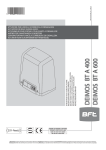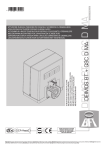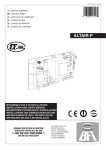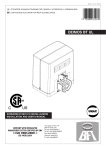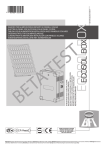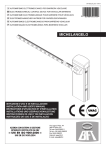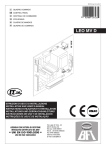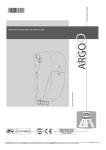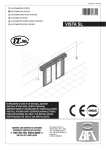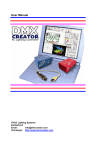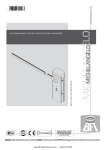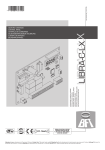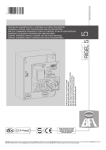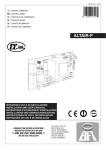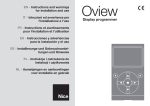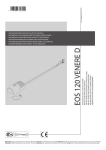Download M - Hansadoor
Transcript
D811627 00100_02 18/02/09 027908 347060 ISTRUZIONI DI INSTALLAZIONE INSTALLATION MANUAL INSTRUCTIONS D’INSTALLATION MONTAGEANLEITUNG INSTRUCCIONES DE INSTALACION INSTALLATIEVOORSCHRIFTEN AUTOMAZIONI PER PORTE SEZIONALI INDUSTRIALI OPERATORS FOR INDUSTRIAL SECTIONAL DOORS AUTOMATISMES POUR PORTES MULTI-LAMES INDUSTRIELLES AUTOMATISCHE ANTRIEBE FÜR INDUSTRIE-SEKTIONALTORE AUTOMATISMOS PARA PUERTAS SECCIONALES INDUSTRIALES AUTOMATISERINGEN VOOR INDUSTRIËLE OPDRACHTGERICHTE DEUREN ARGO ARGO 8 Attenzione! Leggere attentamente le “Avvertenze” all’interno! Caution! Read “Warnings” inside carefully! Attention! Veuillez lire attentivement les Avertissements qui se trouvent à l’intérieur! Achtung! Bitte lesen Sie aufmerksam die „Hinweise“ im Inneren! ¡Atención¡ Leer atentamente las “Advertencias” en el interior! Let op! Lees de “Waarschuwingen” aan de binnenkant zorgvuldig! D811627 00100_02 ITALIANO INSTALLAZIONE VELOCE-QUICK INSTALLATION-INSTALLATION RAPIDE SCHNELLINSTALLATION-INSTALACIÓN RÁPIDA - SNELLE INSTALLATIE A 2 SMONTAGGIO CARTER REMOVING THE COVER DÉMONTAGE DU CARTER ABBAU DER VERKLEIDUNG DESMONTAJE DE CÁRTERES DEMONTAGE CARTER V1 5 mm 10 mm V2 (Fig. C4) 20 mm ENGLISH 1 10 mm V1 C B M FRANÇAIS 1 230Volt PHOT PREDISPOSIZIONE TUBI, TUBE ARRANGEMENT, INSTALLATION DES TUBES, VORBEREITUNG DER LEITUNGEN, DISPOSICIÓN DE TUBOS, VOORINSTELLING BUIZEN V2 DEUTSCH 3 4 2 ESPAÑOL 7 5 8 ARGO - 3 NEDERLANDS 6 REGOLAZIONE FINECORSA, ADJUSTING THE LIMIT SWITCHES RÉGLAGE DE LA FIN DE COURSE, EINSTELLUNG DER ENDSCHALTER REGULACIÓN DE LOS FINALES DE CARRERA,REGELING EINDAANSLAGEN Fusibile, Fuse, Fusible, Schmelzsicherung, Fusible, Zekering. 1,6 AT Led presenza alimentazione, Power ON LED, Voyant LED présence d'alimentation, Led Vorhandensein Stromversorgung, Led Presencia de Alimentación, Led Aanwezigheid voeding Display + tasti programmazione Display plus programming keys Afficheur et touches de programmation Display und Programmierungstasten Pantalla más botones de programación Display meerdere toetsen programmeur 16 17 Luce di cortesia, Courtesy lamp, Lampe de courtoisie, Hilfsbeleuchtung, Luz interior, Hulplicht. 11 9 10 7 8 5 6 3 4 2 1 14 15 1 2 3 4 5 6 7 8 9 10 11 12 13 14 15 PARZ./CLOSE OUT PROG 1 (NO) 24VSafe MAX 180mA Connettore scheda opzionale Optional board connector Connecteur carte facultative Steckverbinder Zusatzkarte Conector de la tarjeta opcional Connector optionele kaart. 24V MAX 180mA 24V MAX 25W BAR START / OPEN SHIELD ANT Connettore programmatore palmare, Palmtop programmer connector, Connecteur programmateur de poche, Steckverbinder Palmtop-Programmierer, Conector del programador de bolsillo, Connector programmeerbare palmtop. 12 13 16 17 SCA / 2CH (NO) OUT PROG 2 (NO) FAULT BAR FAULT PHOT Modulo opzionale SCS-I0, Optional SCS-IO module Module en option SCS-IO, Optional module SCS-IO Módulo opcional SCS-IO, Zusatzmodul SCS-IO 1 2 3 4 5 6 7 4- ARGO DGLCCLBDGL E D811627 00100_02 D D811627 00100_02 F AUTOSET COPPIA APERTURA-CHIUSURA OPENING-CLOSING TORQUE AUTOSETTING RÉGLAGE AUTOMATIQUE COUPLE OUVERTURE-FERMETURE AUTOSET DREHMOMENT ÖFFNUNG-SCHLIESSUNG AJUSTE AUTOMATICO DEL PAR EN FASE DE APERTURA-CIERRE AUTOSET DRAAIMOMENT OPENING - SLUITING. G MEMORIZZAZIONE RADIOCOMANDO MEMORIZING REMOTE CONTROLS MÉMORISATION DE LA RADIOCOMMANDE ABSPEICHERUNG DER FERNBEDIENUNG MEMORIZACIÓN DEL RADIOMANDO MEMORISEREN AFSTANDSBEDIENING + A OK OK x2 B .P+ JMEGA C OK P?BGM D OK %%1202?BHMSRCPQR?PR XSDSCEQR?PR?L?BQR?PR R?QRML?QAMQRMFGBBCL@SRRML RMSAFCA?AFCCTCPQRR?QRC PGJ?QAG?PCJC?QC PCJ?AFCJMQJ?QQCL QSCJRC R?QRMBCQGBCP?RM BCQGBCPCB@SRRMLRMSAFCBCQGPCC ECTSCR?QRCRCAJ?BCQC?B? x2 M CLB ARGO - 5 65.5 min. 86 86 378 77 59 351 292 I Ingresso cavi dall'alto, Cable entry from above, Entrée câbles du haut, Kabeleingang von oben, Entraa cables desde arriba, Ingang kabels van de hoogte APERTURA (GLTKMR=OFF) TO OPEN (AF?LECKMR=OFF) OUVERTURE (GLTKMR=OFF) ÖFFNUNG (KMRR?SQAF=OFF) APERTURA (GLTKMR=OFF) OPENING (AF?LECKMR=OFF) Ingresso cavi dalla parete, Cable entry from wall, Entrée câbles du réseau, Kabeleingang von Wand, Entrada cables desde la pared, Ingang kabels van de wand Ingresso cavi dal basso, Cable entry from below, Entrée câbles du bas, Kabeleingang von unten, Entrada cables desde abajo, Ingang kabels van beneden 230V 24V Diametro medio puleggia [mm], Average pulley diameter [mm], Diamètre moyen poulie [mm], Mittlerer Durchmesser Riemenscheibe [mm], Diámetro promedio polea[mm], Gemiddelde diameter katrol [mm] J 400 ø 250 350 [Numero manovre / giorno] [Number of operations/day] [Nombre manœuvres / jour] [Anzahl Manöver / Tag] [Número maniobras / día] [Aantal manoeuvres / dag] ø 225 300 ø 200 ø 175 250 ø 150 200 ø 125 150 ø 100 100 50 0 1 1,5 2 2,5 3 3,5 4 Altezza porta [m], Door height [m] Hauteur porte [m], Höhe Tür [m] Altura puerta [m], Hoogte deur [m] 6- ARGO 4,5 5 5,5 6 D811627 00100_02 180 max 22 115 H 341 max 226.5 min 226.5 Reeds gememoriseerde afstandsbediening Reeds gememoriseerde afstandsbediening K Te memoriseren afstandsbediening Te memoriseren afstandsbediening 1 2 3 4 5 6 7 8 9 10 11 12 13 14 15 16 17 1 2 3 4 5 6 7 8 9 10 11 12 13 14 15 PHOT 16 17 BAR 1 1 1 TX1 2 L 24V~ 24V~ BAR COM 24V~ 24V~ COM PHOT Collegamento di 1 dispositivo non verificato, Connection of 1 untested device, Branchement de 1 dispositif non vérifié, Anschluss einer Vorrichtung ohne Überprüfung, Conexión de 1 dispositivo no controlado, Verbinding van 1 niet geverifieerde inrichting RX1 1 TX1 2 2 RX1 2 3 3 4 4 5 5 1 2 3 4 5 6 7 8 9 10 11 12 13 14 15 16 17 TX1 M V SAFE + V SAFE - 1 2 3 4 5 6 7 8 9 10 11 12 13 14 15 PHOT 16 17 BAR 1 2 24V~ 24V~ BAR COM V SAFE + V SAFE - 24V~ 24V~ COM PHOT Collegamento di 1 dispositivo verificato, Connection of 1 tested device, Branchement de 1 dispositif vérifié, Anschluss einer Vorrichtung mit Überprüfung, Conexión de 1 dispositivo controlado, Verbinding van 1 geverifieerde inrichting RX1 1 1 2 2 1 TX1 RX1 2 3 3 4 4 5 5 Collegamento di 2 dispositivi verificati, Connection of 2 tested devices, Branchement de 2 dispositifs, Anschluss von zwei Vorrichtungen mit Überprüfungvérifiés, Conexión de 2 dispositivos controlados, Verbinding van 2 geverifieerde inrichtingen 1 2 3 4 5 6 7 8 9 10 11 12 13 14 15 16 17 1 2 3 4 5 6 7 PHOT 1 2 TX1 RX1 1 2 TX2 RX2 24V~ 24V~ V SAFE + V SAFE - BAR 1 2 3 4 5 6 7 8 9 10 11 12 13 14 15 1 1 2 2 16 17 1 2 3 4 5 6 7 BAR TX1 1 RX1 2 3 3 4 4 5 5 1 1 2 2 N FAULT BAR SCS - IO COM FAULT PHOT 24V~ 24V~ V SAFE + V SAFE - PHOT SCS - IO COM D811627 00100_02 PROGRAMMAZIONE TRASMETTITORI REMOTA, REMOTE TRANSMITTER PROGRAMMING, PROGRAMMATION ÉMETTEURS A DISTANCE, FERNPROGRAMMIERUNG DER SENDER, PROGRAMACION DE TRANSMISORES REMOTA, REMOTE PROGRAMMERING TRANSMITTERS 1 TX2 RX2 2 3 3 4 4 5 5 Connessione Seriale Mediante Scheda Scs1 , Serial Connection Via Scs1 Card, Connexion Série À Travers La Carte Scs1, Serielle Verbindung Mit Karte Scs1, Conexión Serial Mediante Tarjeta Scs1, Seriële Verbinding Middels Kaart Scs1 O ARGO - 7 D811627 00100_02 ACCESS TO MENUS Press the OK key Scroll up Scroll down Control unit software version N. total manoeuvres (in tens) Cancel/return to main menu Confirm/Switch on display N. manoeuvres since latest maintenance (in tens) N. radio control devices memorised N?P?K See PARAMETERS MENU ENGLISH N?P?K CLB N?P?K JMEGA JMEGA See LOGIC MENU JMEGA CLB JMEGA P?BGM ?BBQR?PR FGBBCL@SRRML PCJC?QC BCQGPCB@SRRML M BBAF FGBBCL@SRRML PCJC?QC BCQGPCB@SRRML M CLB R See RADIO MENU PC?B .0% CP?QC +/!-"06 ! OK $" OK OK T JGLES? '2 OK - + $0 OK - + CLB "#3 OK - + #,% OK - + CQN BCD?SJR OK .0% CLB (Fig. F) ?SRMQCR CLB JQU?BH LIMIT SWITCH ADJUSTMENT Logic Description .#" 120C 12-. .&-2 0 !*-1 -.#, 1SM 1SA . partial opening input activated 1CR autoset function is running WARNING! Obstacle detection function is not active #0 #0 #0 #0 #0 #0 #0 photocell test error START input activated STOP input activated PHOT input activated SAFETY EDGE input activated CLOSE input activated OPEN input activated opening limit switch activated closing limit switch activated reverse due to obstacle safety edge test error mosfet test error shunt test error encoder test error thermal cutout error optional module communication error 35.40 Set torque threshold % CLB Maximum motor torque % ARGO - 13 WARNING! Important safety instructions. Carefully read and comply with the Warnings booklet and Instruction booklet that come with the product as incorrect installation can cause injury to people and animals and damage to property. They contain important information regarding safety, installation, use and maintenance. Keep hold of instructions so that you can attach them to the technical file and keep them handy for future reference. 1) GENERAL SAFETY - The units making up the machine and its installation must meet the requirements of the following European Directives: 2004/108/EEC, 2006/95/EEC, 98/37/EEC, 89/106/EEC and later amendments. For all countries outside the EEC, it is advisable to comply with the above-mentioned standards, in addition to any national standards in force, to achieve a good level of safety. - The Firm disclaims all responsibility resulting from improper use or any use other than that for which the product has been designed, as indicated herein, as well as for failure to apply Good Practice in the construction of entry systems (doors, gates, etc.) and for deformation that could occur during use. - Make sure the stated temperature range is compatible with the site in which the automated system is due to be installed. - Do not install the product in an explosive atmosphere. - Disconnect the electricity supply before performing any work on the system. Also disconnect buffer batteries, if any are connected. - Have the automated system’s mains power supply fitted with a switch or omnipolar thermal-magnetic circuit breaker with a contact separation of at least 3.0 mm. - Make sure that upline from the mains power supply there is a residual current circuit breaker that trips at 0.03A. - Make sure the earth system has been installed correctly: earth all the metal parts belonging to the entry system (doors, gates, etc.) and all parts of the system featuring an earth terminal. - Installation must be carried out using safety devices and controls that meet standard EN 12978. - Apply all safety devices (photocells, safety edges, etc.) required to keep the area free of crushing, dragging and shearing hazards. - The motor cannot be installed on panels incorporating doors (unless the motor can be activated when the door is open) - If the automated device is installed at a height of less than 2.5 m or is accessible, the electrical and mechanical parts must be suitably protected. - Any fixed controls must be installed within sight of the door but away from moving parts. Unless the control is key operated, it must be installed at a height of at least 1.5 m and in a place where it cannot be reached by the public - Apply at least one warning light (flashing light) in a visible position, and also attach a Warning sign to the structure. - If there are no instructions already, attach a label near the operating device, in a permanent fashion, with information on how to operate the manual release. - Make sure that nothing can be crushed between the guided part and surrounding fixed parts during the door’s operation - Once installation is complete, make sure the motor has the right settings and that the safety and release systems are working properly. - Only use original spare parts for any maintenance or repair work. The Firm disclaims all responsibility for the correct operation and safety of the automated system if parts from other manufacturers are used. - Do not make any modifications to the automated system’s components unless explicitly authorized by the Firm. - Dispose of packaging materials (plastic, cardboard, polystyrene, etc.) in accordance with the provisions of the laws in force. Keep nylon bags and polystyrene out of reach of children. Warning! For connection to the mains power supply, use a multicore cable with a cross-section of at least 4x1.5mm2 of the kind provided for by the regulations mentioned above (by way of example, type H05 VV-F cable can be used with a cross-section of 4x1.5mm2). To connect auxiliary equipment, use wires with a cross-section of at least 1 mm2. Have an omnipolar circuit breaker installed with a contact separation of at least 3 mm and featuring overload protection, suitable for cutting the automated device off from the mains. Only use pushbuttons with a capacity of 10A-250V or more. The cables must be held in position using an extra fixing device in the proximity of the terminals, e.g. with cable clamps. Also add more clips to the limit device wires, to the transformer primary or secondary wires, and to the wires connected to the printed circuit. During installation, the power supply cable must be stripped in order for the earthing wire to be connected to the appropriate terminal, but the active wires must be left as short as possible. The earthing wire must be the last to stretch in the case where the cable fixing device becomes loose. WARNING: extremely low safety voltage cables must be phisically separated from low voltage cables. Access to the electrical compartment or to limit switches must be allowed to skilled personnel only. Compliance with current safety rules with regard to people, animals and property must be assured at all times and, more specifically, measures must be taken to avoid risks of injury due to crushing, in the area where the pinion and rack mesh, and 14 - ARGO any other mechanical hazards. All critical points must be protected by safety devices in accordance with the provisions of the regulations in force. D811627 00100_02 INSTALLATION MANUAL CHECKING THE AUTOMATED DEVICE Before the automated device is finally put into operation, perform the following checks meticulously: t .BLFTVSFBMMDPNQPOFOUTBSFGBTUFOFETFDVSFMZ t Check the correct functioning of all safety devices (limit microswitches, photocells, sensitive edges etc.). t .BLFTVSFUIBUUIFBOUJDSVTITZTUFNTUPQTUIFEPPSXJUIJOUIFMJNJUTQSPWJEFE for by the standards in force. t $IFDLUIFFNFSHFODZPQFSBUJPODPOUSPMEFWJDF t Check the opening and closing operations with the control devices in use. t $IFDLUIFTUBOEBSEBOEDVTUPNJTFEFMFDUSPOJDGVODUJPOJOHMPHJD. USE OF THE AUTOMATED DEVICE Since the automated device can be remote controlled via a remote control or start button, hence with the door out of sight, it is vital that all safety devices be checked frequently to ensure they are in perfect working order. If there is any malfunction, take prompt action, calling in qualified personnel to do the job. You are strongly advised to keep children well out of range of the automated system. Depending on the type of control applied, the automated device must be used in compliance with the installer’s instructions in order to operate without endangering people, animals or property. CONTROL The purpose of using the automated device is to enable motorized door opening and closing. There are various options when it comes to the control system (manual, remote control, access control with magnetic badge etc.) depending on the installation’s needs and characteristics. See the relevant instructions for the various control system options. People due to use the automated device must be instructed how to control and use it. MAINTENANCE When performing maintenance of any kind, cut off power to the system. t $IFDLUIFESJWFTZTUFNBUSFHVMBSJOUFSWBMT t $IFDLBMMTBGFUZEFWJDFTJOTUBMMFEGPSUIFEPPSBOEESJWF. t In the event of any anomalous functioning which cannot be resolved, disconnect the power supply and contact a specialised technician (installer). Whilst the automation is out of order, activate the manual release to allow manual opening and closing. SCRAPPING WARNING! Employ the services of qualified personnel only. Materials must be disposed of in accordance with the regulations in force. There are no particular hazards or risks involved in scrapping the automated system. For the purpose of recycling, it is best to separate dismantled parts into like materials (electrical parts - copper - aluminium - plastic - etc.). DISMANTLING WARNING! Employ the services of qualified personnel only. If the automated system is being dismantled in order to be reassembled at another site, you are required to: t $VUPòUIFQPXFSBOEEJTDPOOFDUUIFXIPMFFYUFSOBMFMFDUSJDBMTZTUFN t 4FFUPUIFSFQMBDFNFOUPGBOZDPNQPOFOUTUIBUDBOOPUCFSFNPWFEPSIBQQFO to be damaged. D811627 00100_02 INSTALLATION MANUAL 2) GENERAL INFORMATION Actuator for motorizing residential and industrial sectional doors. Its compact design and mounting versatility mean the drive can be applied in different ways. 3) TECHNICAL SPECIFICATIONS Power supply: 230V ±10%, 50/60Hz (*) Max. power input: 70W Limit switch: Electronic ENCODER model Output shaft MAX. 18 rpm Courtesy light: 24V bulb ~ max. 25W, E14 Operating temperature range: -15°C / +55°C Max. door size: 20 m2 Max. torque: 55 Nm Lubrication: Lifetime greased Knob-operated mechanical release Protection rating: IP 40 Noise level: <70dBA Operator weight: 10 kg Dimensions: See Fig. H Accessories power supply: 24V~ (180 mA) 24V max 25W Fuses: See Fig. D Built-in Rolling-Code radio-receiver: frequency 433.92MHz 8) ADJUSTMENTS RECOMMENDED ADJUSTMENT SEQUENCE: Adjusting the limit switches (Fig. E) Autoset (Fig. F) Programming remote controls (Fig. G) Setting of parameters/logic, where necessary 8.1) PARAMETERS MENU (N?P?K) (TABLE “A” PARAMETERS) Manual operation: Flashing light connection: 7.1) SAFETY DEVICES Note: only use receiving safety devices with free changeover contact. Fig. L: Connection of 1 untested device (photocell or safety edge). Fig. M: Connection of 1 tested device (photocell or safety edge). Fig. N: Connection of 2 tested devices (photocells or safety edges). This connection is made possible via the SCS-IO optional module only. 8.2) LOGIC MENU (JMEGA) (TABLE “B” LOGIC) 8.3) RADIO MENU (0"'-) Logic ?BBQR?PR Add 2ch Key associates the desired key with the 2nd radio channel command PC?B Read Checks a key of a receiver and, if memorized, returns the number of the receiver in the memory location (from 01 to 64) and number of the key (T1-T2-T3 or T4). CP?QC Erase List WARNING! Erases all memorized remote controls from the receiver’s memory. AMB06 Read receiver code Displays receiver code required for cloning remote controls. SI ON = Enables remote programming of cards via a previously memorizedW LINK transmitter. It remains enabled for 3 minutes from the time the W LINK remote control is last pressed. OFF=W LINK programming disabled. . 4) REMOVING THE COVER Fig. A 5) TUBE ARRANGEMENT Fig. B 6) INSTALLING THE OPERATOR Fig. C 5) CABLE ENTRY FIG. I 6) MANUAL RELEASE (See USER GUIDE -FIG. Y-). ---------------------------------------------------------7) WIRING TERMINAL DESCRIPTION JP2 Transformer wiring JP10 Motor wiring 1-2 Antenna input for built-in radio-receiver board (1:BRAIDING 2: SIGNAL) 3-4 START/OPEN INPUT (N.O.) 3-5 STOP input (N.C.) If not used, leave jumper inserted 3-6 PHOTOCELL input (N.C.) If not used, leave jumper inserted 3-7 SAFETY EDGE input (N.C.) If not used, leave jumper inserted 8-9 24 V~ output for flashing light (max. 25 W) 10-11 24V~ max. 180mA output - power supply to photocells or other devices. 12-13 24V~ Vsafe max. 180mA output - power supply to transmitters photocells with test. 14-15 (NO contact) / Output 1 height programmable 16-17 PARTIAL OPENING/CLOSE input (N.O.) 1-2 (SCS-IO) PHOT-FAULT input (NO). Input for photocells equipped with NO test contact. 1-3 (SCS-IO) BAR-FAULT input (NO). Input for safety edges equipped with NO test contact. 4-5 (SCS-IO) (NO contact) / Output 2 Height programmable 6-7 (SCS-IO) Gate open light/2nd radio channel output (NO contact) Add Start Key associates the desired key with the Start command ?BBAF (*) Special supply voltages to order. Usable transmitter versions: All ROLLING CODE transmitters compatible with Description - IMPORTANT NOTE: THE FIRST TRANSMITTER MEMORIZED MUST BE IDENTIFIED BY ATTACHING THE KEY LABEL (MASTER). In the event of manual programming, the first transmitter assigns the RECEIVER’S KEY CODE: this code is required to subsequently clone the radio transmitters. The Clonix built-in on-board receiver also has a number of important advanced features: t $MPOJOHPGNBTUFSUSBOTNJUUFSSPMMJOHDPEFPSöYFEDPEF t $MPOJOHUPSFQMBDFUSBOTNJUUFSTBMSFBEZFOUFSFEJOSFDFJWFS t 5SBOTNJUUFSEBUBCBTFNBOBHFNFOU t 3FDFJWFSDPNNVOJUZNBOBHFNFOU To use these advanced features, refer to the universal handheld programmer’s instructions and to the CLONIX Programming Guide, which come with the universal handheld programmer device. 8.4) LANGUAGE MENU (J?LES?EC) Used to set the programmer’s language on the display. 8.5) DEFAULT MENU (BCD?SJR) Restores the controller’s default factory settings. 8.6) AUTOSET MENU (SRMQCR) (Fig. F) t .PWFUIFEPPSUPUIFDMPTFEQPTJUJPO t -BVODIBOBVUPTFUPQFSBUJPOCZHPJOHUPUIFSFMFWBOUNFOVPOUIF7&/&3& D panel. t "TTPPOBTZPVQSFTTUIF0,CVUUPOUIFiwNFTTBHFJTEJTQMBZFEBOE the control unit commands the door to perform a full cycle (opening followed by closing), during which the minimum torque value required for the door to move is set automatically. During this stage, it is important to avoid breaking the photocells’ beams and not to use the START and STOP commands or the display. Once this operation is complete, the control unit will have automatically set the optimum torque values. Check them and, where necessary, edit them as described in the programming section. WARNING: Check that the force of impact measured at the points provided for by standard EN 12445 is lower than the value laid down by standard EN 12453. ARGO - 15 Warning!! While the autoset function is running, the obstacle detection function is not active. Consequently, the installer must monitor the automated system’s movements and keep people and property out of range of the automated system. 8.7) LIMIT SWITCH ADJUSTMENT MENU (*15"() (Fig . E) Limit switch adjustment procedure: 1) Go to L.SW ADJ and confirm with OK. 2) The display reads CLOSE. Use the UP and DOWN keys to move the door to the closing limit switch position. Confirm with OK. The display reads PRG. 3) If prompted by the display, turn the adjustment ring: anticlockwise if the display reads UP; clockwise if the display reads DOWN. Once you have reached the correct position, the display reads OK. Confirm with the OK key. The display reads PRG. 4) The display reads OPEN. Use the UP and DOWN keys to move the door to the opening limit switch position. Confirm with OK. The display reads PRG. If the display reads KO, it means adjustment was not successful. This may be caused by: - the ESC key being pressed before adjustment was completed - stored travel being too short 9) SCS OPTIONAL MODULES 9.1) SERIAL CONNECTION VIA SCS1 CARD (Fig. O) The VENERE D control panel’s special serial inputs and outputs (SCS1) make the centralized connection of a number of automated devices possible. That way, all the automated devices connected can be opened or closed with a single command. Connect all VENERE D control panels using twisted pair cabling only, proceeding as shown in the diagram in Fig. O. When using a telephone cable with more than one pair, it is essential to use wires from the same pair. The length of the telephone cable between one unit and the next must not be greater than 250 m. At this point, each VENERE D control panel needs to be configured appropriately, starting by entering a MASTER control panel that will have control over all the others, which therefore have to be set as SLAVE units (see logic menu). Also set the Zone number (see parameters menu) in the range 0 to 127. The zone number allows you to create groups of automated devices, each of which answers to the Zone Master. Each zone can have only one Master: the Master of zone 0 also controls the Slaves of the other zones. 9.2) Interface with WIEGAND systems via SCS-WIE module. Refer to the SCS-WIE module’s instructions. 9.3) Expanding inputs and outputs via the SCS-IO optional module. The SCS-IO optional module can be used to add 2 inputs and 2 outputs to the VENERE-D board (Fig. D). To activate the connection between SCS-IO and VENERE-D, you need to plug the SCS-IO module into the relevant connector and then set the ZONE parameter to 129. At this point, the 2 boards are synchronized and the SCS-IO board’s inputs/outputs are managed by the VENERE-D board. TABLE “A” - PARAMETERS MENU - (.0+) Logic RA? MNRQJMT AJQRQJMT MNQNCCB min. max. default 0 120 40 1 1 10 99 99 99 75 75 99 Definition Description Automatic Closing Time Automatic closing time [s] Opening motor torque Opening torque [%] Sets sensitivity to obstacles during opening (1=max., 99=min.) The autoset feature sets this parameter automatically to a value of 10%. The user can edit this parameter based on how sensitive the door needs to be to obstacles. Closing motor torque Closing torque [%] Sets sensitivity to obstacles during closing (1=max., 99=min.) The autoset feature sets this parameter automatically to a value of 10%. The user can edit this parameter based on how sensitive the door needs to be to obstacles. Speed during opening Running speed during opening [%] Sets the running speed that the door must reach during opening, as a percentage of the maximum speed the actuator can reach. Should this parameter be edited, it will be followed by a complete opening/closing cycle for setting purposes (reported by the message “SET” appearing on the display), during which obstacle detection is not enabled. AJQNCCB 10 99 99 Speed during closing Running speed during closing [%] Sets the running speed that the door must reach during closing, as a percentage of the maximum speed the actuator can reach. Should this parameter be edited, it will be followed by a complete opening/closing cycle for setting purposes (reported by the message “SET” appearing on the display), during which obstacle detection is not enabled. BGQRQJMSB 5 99 10 Slow-down distance Slow-down distance [%] Sets the approach distance to reach the travel limit. This distance is travelled at low speed. N?PRG?JMNCLGLE 10 99 40 Partial opening Partial opening [%] Adjusts partial opening percentage compared to total opening in “Partial open” mode. XMLC 0 129 0 Zone Zone [] Sets the zone number of the door included in the serial connection for commands via central controllers. Zona=128 not used. Zone=129 Use of optional SCS -I0 module. MSRNPME 1 99 50 MSRNPME 1 99 50 16 - ARGO Output 1 height programmable Output 2 height programmable The output between terminals 14-15 is activated when the door exceeds the opening percentage set with this parameter (1% = door closed, 99% = door open). The output between terminals 4-5 on the SCS-IO optional module is activated when the door exceeds the opening percentage set with this parameter (1% = door closed, 99% = door open). D811627 00100_02 INSTALLATION MANUAL D811627 00100_02 INSTALLATION MANUAL TABLE “B” - LOGIC MENU - (JMEGA) Logic min. max. default Definition RA? --- --- OFF Automatic Closing Time ON OFF Switches automatic closing on Switches automatic closing off G@JMNCL --- --- OFF Block Pulses ON OFF The start pulse has no effect during opening. The start pulse has effect during opening. ON Switches to 3-step logic. A start pulse has the following effects: door closed: opens during opening: stops and switches on TCA (if configured). door open: closes during closing: stops and opens again Switches to 4-step logic. A start pulse has the following effects: door closed: opens during opening: stops and switches on TCA (if configured) door open: closes during closing: stops and does not switch on tca (stop) QRCN --- --- OFF 3 Step NPC?J?P --- --- OFF Pre-alarm FMJBRMPSL --- --- OFF Deadman Description OFF ON OFF The flashing light comes on approx. 3 seconds before the motors start. The flashing light comes on at the same time as the motors start ON Deadman mode during closing: opening operation performed in automatic mode; closing operation continues as long as the control key is held down. (CLOSE). Pulse operation (standard) OFF ON: NFMRMAMNCL --- --- OFF Photocells during opening RCQRNFMR --- --- OFF Photocell test RCQR@?P ?QRCP DGVCBAMBC P?BGMNPME When beam is broken, operation of the photocell is switched off during opening. During closing, movement is reversed immediately. OFF: When beam is broken, photocells are active during both opening and closing. When beam is broken during closing, movement is reversed only once the photocell is cleared. ON OFF Switches photocell testing on Switches photocell testing off If disabled (OFF), it inhibits the photocell testing function, enabling connection of devices not equipped with supplementary test contacts. ON OFF Switches safety edge testing on Switches safety edge testing off If disabled (OFF), it inhibits the safety edge testing function, enabling connection of devices not equipped with supplementary test contacts --- --- OFF Safety edge testing --- --- OFF Master/Slave ON OFF Control panel is set up as the Master unit in a centralized connection system. Control panel is set up as a Slave unit in a centralized connection system. --- --- OFF Fixed code ON OFF Receiver is configured for operation in fixed-code mode. Receiver is configured for operation in rolling-code mode. ON Enables wireless memorizing of transmitters: (Fig. K) 1- Press in sequence the hidden key (P1) and normal key (T1-T2-T3-T4) of a transmitter that has already been memorized in standard mode via the radio menu. 2- Press within 10 sec. the hidden key (P1) and normal key (T1-T2-T3-T4) of a transmitter to be memorized. The receiver exits programming mode after 10 sec.: you can use this time to enter other new transmitters. This mode does not require access to the control panel. Disables wireless memorizing of transmitters. Transmitters are memorized only using the relevant Radio menu. --- --- ON Remote control programming OFF ON The output between terminals 6-7 on the optional SCS-10 module is set as Gate open light: in this case, the 2nd radio channel controls pedestrian opening. The output between terminals 6-7 on the optional SCS-10 module is set as 2nd radio channel QA?AF --- --- OFF Gate open light or 2nd radio channel OFF QR?PRMNCL --- --- OFF Selection START - OPEN ON OFF Input between terminals 3-4 works as OPEN. Input between terminals 3-4 works as START NCBAJMQC --- --- OFF Selection PEDESTRIAN CLOSE ON OFF Input between terminals 16-17 works as CLOSE. Input between terminals 16-17 works as PEDESTRIAN AF?LEC MR --- --- OFF Reversing motion ON OFF Reverses motion of standard rotation (See Fig.I). Standard rotation (See Fig.I). ARGO - 17 FIG. Y A B Verde - Green-Vert-Grün-Verde-Groen Rosso-Red-Rouge-Rot-Rojo-Rood 38 - ARGO C D811627 00100_02 MANUALE D’USO: MANOVRA MANUALE - USER’S MANUAL: MANUAL OPERATIONMANUEL D’UTILISATION: MANŒUVRE MANUELLE - BEDIENUNGSANLEITUNG: MANUELLES MANÖVERMANUAL DE USO: ACCIONAMIENTO MANUAL - GEBRUIKSHANDLEIDING: MANUEEL MANOEUVRE












